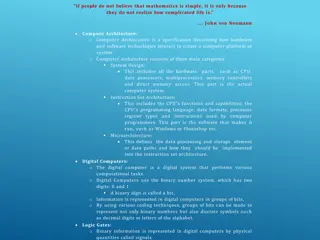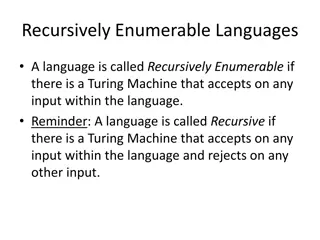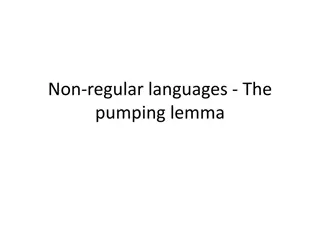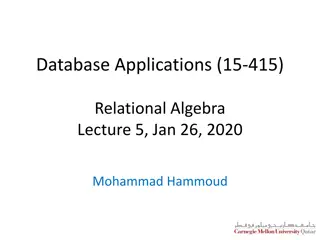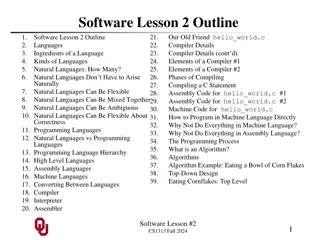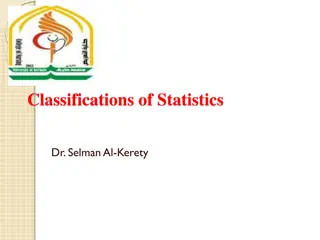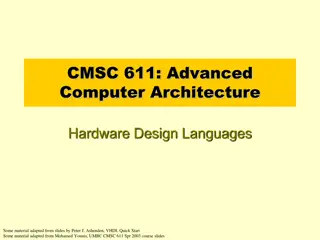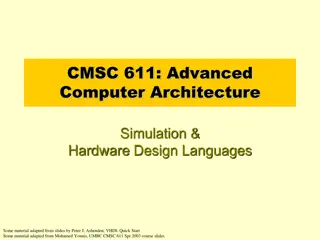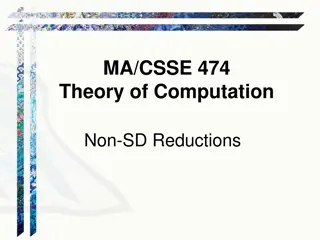Understanding Hardware Descriptive Languages in Digital Systems
Hardware Descriptive Languages (HDLs) are used to represent various aspects of digital systems, including truth tables, Boolean expressions, gate diagrams, and complex functions. They find application in design entry, logic simulation, functional verification, circuit synthesis, timing verification, fault simulation, and documentation. The language manual for declarations in HDL describes syntax, reserved words, and rules for identifiers. Verilog, a case-sensitive language, allows modeling of digital systems using structural, algorithmic, or behavioral approaches. Verilog constructs involve modules, port lists, gates, and gate instantiations. An example circuit model is presented to demonstrate Verilog syntax, including gate connections and output definitions.
Download Presentation

Please find below an Image/Link to download the presentation.
The content on the website is provided AS IS for your information and personal use only. It may not be sold, licensed, or shared on other websites without obtaining consent from the author. Download presentation by click this link. If you encounter any issues during the download, it is possible that the publisher has removed the file from their server.
E N D
Presentation Transcript
Hardware Descriptive Languages these notes are taken from Mano s book It can represent: Truth Table Boolean Expression Diagrams of gates and complex functions Signals Gates, and complex functions A Complete Digital System 2024-09-18 1
HDL, Area of Application Design Entry Logic Simulation Functional Verification Digital Circuit Synthesis Timing Verification Fault Simulation Documntation 2024-09-18 2
Declarations Language Manual describes Syntax Reserved words .around 100 Reserved words are lower case: module, endmodule, input, output, wire, timescale .. // is used for comments /* .*/ Is used for multi-line comments Blank spaces are ignored Blank spaces may not appear within a reserved word, identifier, an operator or a number 2024-09-18 3
Declarations Verilog is case sensitive module .. Must be closed with endmodule and there is no ; after endmodule. Combinational Logic can be described by: Boolean Equations , Truth Table, Schematic Capture A digital System can be modeled in structural, algorithmic or behavioural. 2024-09-18 4
Identifiers Are case sensitive, Must NOT start with numeric characters They may contain the underscore _ Example: Asim Al_Khalili Al-khalili COEN212 2024-09-18 5
Verilog Constructs Each module starts with reserved word module and ends with endmodule. The port list is enclosed within parenthesis. Commas are used to separate the elements. All statements must end with a ; . input and out define the ports. wire defines the internal connections. Gates are defined with reserved words and, not or Each gate is called by a gate instantiation. Gates names are optional but help in identifying the circuit. Gate output, inputs are ordered separated with a comma and enclosed by parenthesis. 2024-09-18 6
Example (Manos book 4thEdition) A B G1 w1 G3 D C G2 E // Verilog model circuit of above figure. IEEE 1364-1995 Syntax module Simple_Circuit (A,B,C,D,E); output D,E; input A,B,C; wire w1; and G1 (w1,A,B); not G2 (E,C); or G3 (D,w1,E); endmodule 2024-09-18 7
Delays The propagation delay is specified in terms of time units and is specified by the symbol # and #(10) G1 (w1, A,B) The association of time unit and the time scale is made with the compiler directive timescale The directive is specified before the declaration of a module timescale 1 ns/100ps indicates unit of measurement for time delay followed by the precision round off. 2024-09-18 8
Test Bench T_Simple_Circuit Test generator Circuit Stimulator Circuit reg wire // Test bench for Simple_Circuit__delay module t_Simple_Circuit_delay; wire D,E; // circuit output of the circuit to be tsted within the test bench reg A,B,C; // output from stimulator and input to the circuit Simple_Circuit_delay M1 (A,B,C,D,E); //instantiation of M1 Initial // statement to describe the testing waveform begin A= 1 b0; B=1 b0; C=1 b0; // one binary digit with a value of 0 for A,B and C #100 A=1 b1; B=1 b1; C=1 b1; // after 100 ns inputs are changed to ABC 111 end Initial #200 $finish; // end of the test application, ie. entire test simulation time endmodule 2024-09-18 9
Example (Mano s book 4thEdition) A (30ns) w1 (20 ns) B G1 G3 D E C G2 (10) ns // Verilog model circuit of above figure. IEEE 1364-1995 Syntax module Simple_Circuit_with_delay (A,B,C,D,E); Input A B C Output E w1 D Time units (ns) output D,E; input A,B,C; 0 0 0 1 0 1 Initial 1 1 1 1 0 1 initial wire w1; 10 1 1 1 0 01 and #(30) G1 (w1,A,B); 20 1 1 1 0 0 1 not #(10) G2 (E,C); 30 1 1 1 0 1 0 40 1 1 1 0 1 0 or #(20)G3 (D,w1,E); 50 1 1 1 0 1 1 endmodule 2024-09-18 10
Example (Manos book 4thEdition) A 30 ns w1 20 ns B G1 G3 D C 10 ns E G2 A B C W1 E D 100 110 130 150 2024-09-18 11
Boolean Expressions Use reserved word assign and &, | and ~ for AND,OR,NOT Example: // Boolean Circuit representation module Boolean Circuit (E,F,A,B,C,D); output E,F; input A,B,C,D; assign E= A| (B&C)|(~B&D); // A + (B.C) + (B .D) assign F= (~B &C) | (B& ~C & ~D); // (B .C) + (B.C .D ) endmodule 2024-09-18 12
User Defined Primitives System primitives: and, or, nand, xor One way is to define own primitive by a Truth Table . Use primitive and endprimitive to create a UDP It is declared with the reserved word primitive followed by a name and port list One output and it must be listed first in the port listing and following the output declaration Any number of inputs, however the order given in the port declaration must be the same as the Table The table must start with the reserved word table and end with endtable The values of the inputs are listed in order and separated from output by : the line ends with ; 2024-09-18 13
User Defined Primitives Example: // Verilog model: User Defined Primitive primitive UDP_02467 (D,A,B,C); output D; input A,B,C; // Truth Table for D= f( A, B ,C ) = m(0,2,4,6,7); table // A B C : D // headers 0 0 0 : 1; 0 0 1 : 0; 0 1 0 : 1; 0 1 1 : 0; 1 0 0 : 1; 1 0 1 : 0; 1 1 0 : 1; 1 1 1 : 1; endtable endprimitive 2024-09-18 14
Calling of UDP // Verilog model: Circuit instantiation of Circuit_UPD_02467 module Circuit_with UDP_02467 (e,f,a,b,c,d); output e,f; input a,b,c,d; UDP_02467 (e,a,b,c); and (f,e,d); endmodule a UDP_02467 e b c f d 2024-09-18 15
VHDL EXAMPLE -- Interface 1 entity XOR_2 is 2 Port .3 (A,B : in BIT; Z : out BIT); 4 end XOR_2; 5 -- Body 6 Signal Reserved word architecture DATA_FLOW of XOR_2 is 7 Declaration signal Sig 1, Sig 2: BIT; 8 begin 9 Sig 1 <= A and not B; ..10 Concurrent assignment statement Sig 2 <= B and not A; 11 Z <=Sig1 or Sig 2; 12 16 end DATA_FLOW; 13
VHDL Full Adder Example library ieee; use ieee.std_logic_1164.all; entity Full_Adder is -- generic (TS : TIME := 0.11 ns; TC : TIME := 0.1 ns); port (X, Y, Cin: in std_logic; Cout, Sum: out std_logic); end Full_Adder; architecture Concurrent of Full_Adder is begin Sum <= X xor Y xor Cin after 0.11 ns ; Cout <= (X and Y) or (X and Cin) or (Y and Cin) after 0.11 ns; end Concurrent; 18
Example : VHDL Multiplier, Simulation Results Multiplicand = 100010012 = Multiplier = 101010112 Expected Result = 1011011100000112 =5B8316 8916 AB16 =





